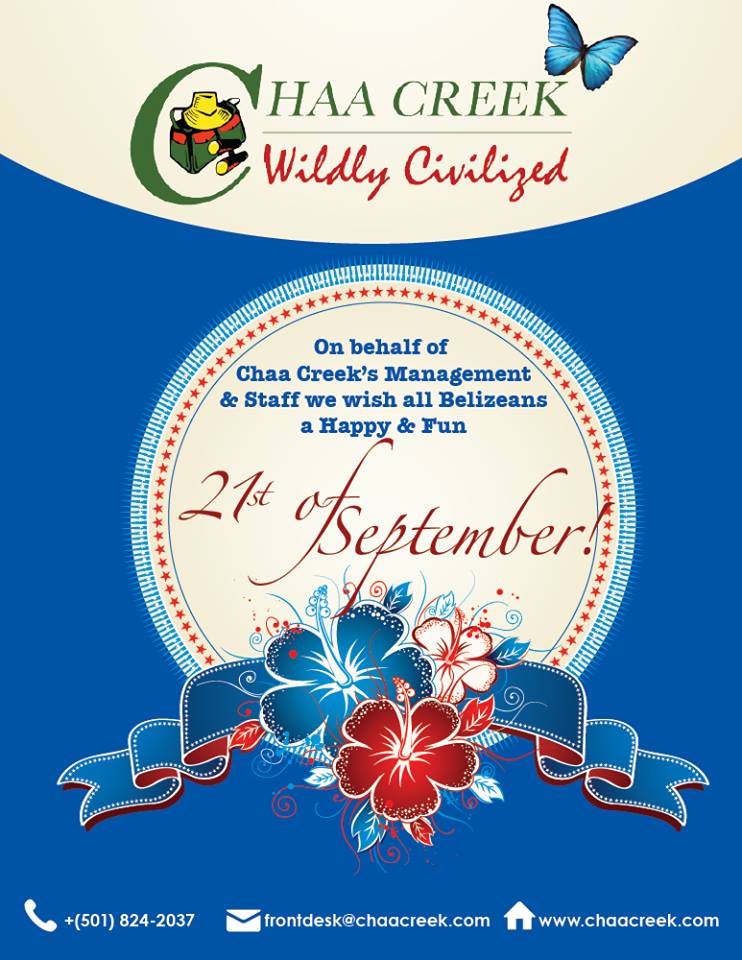As a young nation celebrating its 32nd birthday, Belize is understandably enthusiastic about Independence Day, and this year’s September 21 celebration is shaping up to be one of the biggest yet, according to the owners of Belize’s first eco-resort, The Lodge at Chaa Creek.
Lucy Fleming, who with her husband Mick opened Chaa Creek’s doors on the same date that Belize achieved independence from Great Britain, said she’s not surprised that Belizean nationalism shows no signs of waning.
“I imagine that independence day celebrations were wildly enthusiastic in the young United States of America around 1808 while Americans were still basking in their new found liberty and sense of national identity.
“We’re undergoing the same thing in Belize right now. There’s a lot of pride, excitement, and energy in watching your new nation grow and take its place in the world. There’s a real feeling of having arrived mixed with excitement about the future.
“We’ve come a long way in 32 years and we’re still just recognising the amount of opportunities and challenges that lie ahead. I can’t think of any place I’d rather be,” Ms Fleming said.
While the nation of Belize is relatively new, records of its colourful history go back thousands of years, beginning with Maya settlements that grew into some of the most advanced cities in the ancient world, with over 100,000 inhabitants living in carefully planned, thriving metropolises. In fact, the tallest buildings in Belize to this day are still the ancient Maya temples at Xunantunich and Caracol, which at its peak boasted a larger population than present day Belize City.
The Maya civilisation was in decline by the time the Spanish Conquistadors arrived in the early 1500s, to be followed by the first English settlers, a motley, adventurous group who made a living cutting timber, especially logwood, which was prized as the source of an indigo textile dye and ink for the quill pens of the day.
Tradition has it that the Belize of that time was a favourite port for pirates, whose knowledge of the Belize Great Barrier Reef was essential in helping them avoid capture and hide their booty.
By the late 1700s the area had established its own identity, with the English settlers known as Baymen and African slaves intermingling to create a mixed race population known as Creoles. When they fought “shoulder to shoulder” to defeat a superior Spanish invasion force at St Georges’ Caye in 1798, the identity of what became the crown colony of British Honduras was solidified.
The Garifuna arrived in 1832 as another distinct ethnic group that became an integral part of the Belizean national character. Comprised of the indigenous Arawak inhabitants of St Vincent’s Island and African slaves who were shipwrecked off its coast, Garifuna had been exiled by the British to the Mosquito Coast where, instead of dying out as expected, they established villages along the coasts of what became Belize, Honduras, Guatemala and Nicaragua, preserving their own distinct culture and language while occupying positions as teachers, police, public servants in the colonial days, Ms Fleming said.
Adding to Belize’s unique cultural makeup were American Civil War veterans, German speaking Mennonites seeking religious freedom and a range of Lebanese, East Indian, European, North American, Asian and other immigrants.
“When we first arrived in Belize in the 1970s you couldn’t help but be struck by the harmonious diversity of the people. It was, and is, a true melting pot, and as independence approached the feeling of national unity was palatable wherever you went. It was an incredibly exciting time and that spirit still comes alive every year,” Ms Fleming said.
Each year an independence day theme is selected by way of a national contest, with “Belize In You, Belize In Me, Land Of The Free,” penned by Jeanelle Mencias, selected as the theme for 2013.
Ms Fleming said that independence celebrations began September 10 with St George’s Caye Day and have been gaining momentum across the nation since then. “It’s pretty much been a nonstop party since the tenth. Out on Ambergris Caye on the Belize Great Barrier Reef and along the coast events have a more Caribbean flavour, while the border towns near Mexico and Guatemala will have more of a fiesta atmosphere, and in the villages down south there will be a lot of distinctive Garifuna drumming and music.
“I think we’re seeing more visitors to Belize this year for the Independence celebrations due to positive word of mouth, which is adding even more of an international flavour to what is already such a mixed bag of events and activities, and it’s great to see things grow so much each year.
“As word continues to spread, I think we can look forward to Belizean Independence Day becoming an internationally recognised event. Where else can you see such an eclectic mixture of ethnic backgrounds acting together so harmoniously and towards one common goal? I like to think that little Belize can become an example to the rest of the world. That would be something to celebrate,” Ms Fleming said.
Did you enjoy this post? Stay up to date with all of our Belize Travel Blogs and Tips by following us on Twitter and Facebook.
